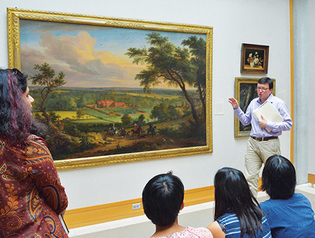 loading
loading
Light & VerityEnd of an art history class draws protestReports of the death of European art at Yale are greatly exaggerated.  Michael MarslandHistory of art chair Tim Barringer said in January that Yale’s long-lived introductory survey courses will be discontinued. View full imageOn a Tuesday in January, during his first lecture of the semester in Introduction to the History of Art: Renaissance to the Present, Tim Barringer told students that after this term, the survey course would no longer be offered. As a result, two things happened before the week was over: enrollment in the already popular course surged, and many national media seized on the story as another example of political correctness ruining once-great universities. For Barringer, the Paul Mellon Professor of the History of Art and the chair of the department, the excitement was a surprise. The department wasn’t doing anything drastic: the classics of European art would still hold their major place in the curriculum. To him, the decision to eliminate the department’s two long-lived introductory surveys was the result of “the kind of questioning that has gone on in art history departments for decades.” “This is not something that’s out of step with the rest of the profession at all,” says Barringer. When the news broke, he says, “art historians were saying, ‘You’re still teaching that thing?’” Neither Harvard nor Princeton offers a comprehensive introductory survey. Barringer adds that, unlike the English department’s 2017 changes to its program (it dropped the requirement for prospective majors to take English 125, Major English Poets), the art history changes were not preceded by any organized student protests or feedback. In a statement approved by the department’s faculty, Barringer wrote that the faculty believed that “no one survey course taught in the space of a semester could ever be comprehensive, and that no one survey course can be taken as the definitive survey of our discipline.” And offering a pair of introductory courses that focuses almost exclusively on Western art, he says, conveys “a sense that one thing is central and all else is peripheral.” Instead, Barringer says, the department will offer an array of four introductory courses “of equal prominence” each year. These will include “chronologically organized courses on European and American art of all periods,” introductions to major world traditions such as Asian and African art, and thematic courses such as Global Sacred Spaces or The Silk Road. In a Wall Street Journal op-ed, art critic Roger Kimball ’82MPhil called the decision “another sign that Yale has succumbed to a life-draining decadence.” In Commentary, Christine Rosen says it was part of a plan in academia “to purge the curriculum of more-traditional courses and replace them with ones that view the study of the past as a power struggle with clear villains and victims.” Barringer’s own scholarly work focuses on British and American art—he is cocurator of a touring exhibition called Victorian Radicals that is now on display at the Center for British Art—and he hastens to point out that Yale has lost no enthusiasm for the art of the West. “We are teaching the work of the Western canon,” he says. “We encourage people to think about how it came to be and what they would add to it.”
The comment period has expired.
|
|